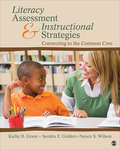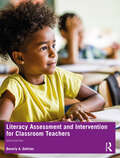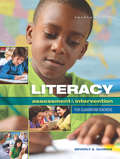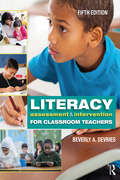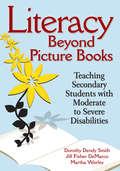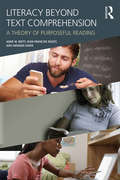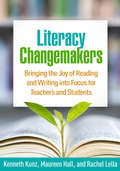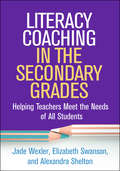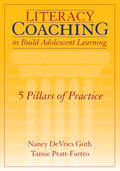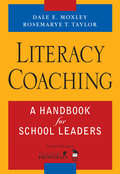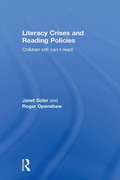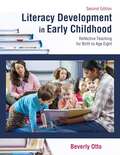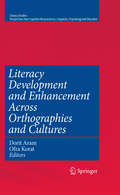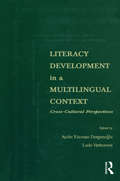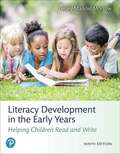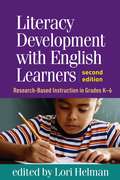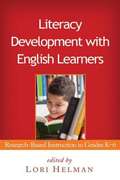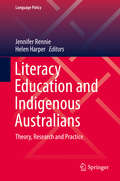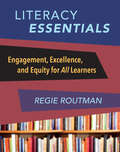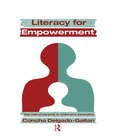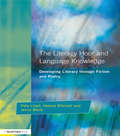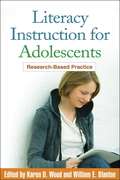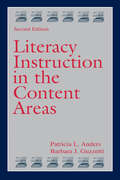- Table View
- List View
Literacy Assessment and Instructional Strategies: Connecting to the Common Core
by Nance S. Wilson Kathy Beth Grant Sandra E. GoldenLiteracy Assessment and Instructional Strategies prepares literacy educators to conduct reading and writing assessments and develop appropriate corrective literacy strategies for use with their grade K–5 students. Connecting Common Core Literacy Learning Standards to effective strategies and creative activities, the book includes authentic literacy assessments and formal evaluations to support reading teaching in the elementary classroom. Initial chapters discuss literacy assessment and evaluation, data-driven instruction, high-stakes testing, and instructional shifts in teaching reading, while later chapters focus on the latest instructional and assessment shifts, including pre-assessing literacy knowledge bases, using informational texts for vocabulary development, and close reading of text. Written by reading practitioners and researchers, this book is a must-have for novices as well as for veteran classroom teachers who want to stay on top of changing literacy trends.
Literacy Assessment and Instructional Strategies: Connecting to the Common Core
by Nance S. Wilson Kathy Beth Grant Sandra E. GoldenLiteracy Assessment and Instructional Strategies prepares literacy educators to conduct reading and writing assessments and develop appropriate corrective literacy strategies for use with their grade K–5 students. Connecting Common Core Literacy Learning Standards to effective strategies and creative activities, the book includes authentic literacy assessments and formal evaluations to support reading teaching in the elementary classroom. Initial chapters discuss literacy assessment and evaluation, data-driven instruction, high-stakes testing, and instructional shifts in teaching reading, while later chapters focus on the latest instructional and assessment shifts, including pre-assessing literacy knowledge bases, using informational texts for vocabulary development, and close reading of text. Written by reading practitioners and researchers, this book is a must-have for novices as well as for veteran classroom teachers who want to stay on top of changing literacy trends.
Literacy Assessment and Intervention for Classroom Teachers
by Beverly A. DeVriesThe Sixth Edition of this comprehensive resource helps future and practicing teachers recognize and assess literacy problems, while providing practical, effective intervention strategies to help every student succeed. DeVries thoroughly explores all major components of literacy, offering an overview of pertinent research, suggested methods and tools for diagnosis and assessment, intervention strategies and activities, and technology applications to increase students' skills. Substantively updated to reflect the needs of teachers in increasingly diverse classrooms, the Sixth Edition addresses scaffolding for English language learners and the importance of using technology and online resources. It presents appropriate instructional strategies and tailored teaching ideas to help both teachers and their students. The valuable appendices feature assessment tools, instructions, and visuals for creating and implementing the book's more than 150 instructional strategies and activities, plus other resources. New to the Sixth Edition: Up to date and in line with national, state, and district literacy standards, this edition covers the latest shifts in teaching and the evolution of these standards. New material on equity and inclusive literacy instruction, understanding the science of reading, using technology effectively, and reading and writing informational and narrative texts. New intervention strategies and activities are featured in all chapters and highlight a stronger technology component. Revamped companion website with additional tools, videos, resources, and examples of teachers using assessment strategies.
Literacy Assessment and Intervention for Classroom Teachers
by Beverly DevriesThe fourth edition of this comprehensive resource helps future and practicing teachers recognize and assess literacy problems, while providing practical, effective intervention strategies to help every student succeed. The author thoroughly explores the major components of literacy, providing an overview of pertinent research, suggested methods and tools for diagnosis and assessment, intervention strategies and activities, and technology applications to increase students' skills. Discussions throughout focus on the needs of English learners, offering appropriate instructional strategies and tailored teaching ideas to help both teachers and their students. Several valuable appendices include assessment tools, instructions and visuals for creating and implementing the book's more than 150 instructional strategies and activities, and other resources.
Literacy Assessment and Intervention for Classroom Teachers: For Classroom Teachers
by Beverly A. DeVriesThe fifth edition of this comprehensive resource helps future and practicing teachers recognize and assess literacy problems, while providing practical, effective intervention strategies to help every student succeed. DeVries thoroughly explores the major components of literacy, offering an overview of pertinent research, suggested methods and tools for diagnosis and assessment, intervention strategies and activities, and technology applications to increase students' skills. Updated to reflect the needs of teachers in increasingly diverse classrooms, the fifth edition addresses scaffolding for English language learners, and offers appropriate instructional strategies and tailored teaching ideas to help both teachers and their students. Several valuable appendices include assessment tools, instructions and visuals for creating and implementing the book's more than 150 instructional strategies and activities, and other resources. New to the Fifth Edition: Up-to-date and in line with ILA, CCSS, and most state and district literacy standards, this edition also addresses the important shifts and evolution of these standards. New chapter on Language Development, Speaking, and Listening covers early literacy, assessment, and interventions. New intervention strategies and activities are featured in all chapters and highlight a stronger technology component. Updated Companion Website with additional tools, resources, and examples of teachers using assessment strategies.
Literacy Beyond Picture Books: Teaching Secondary Students With Moderate to Severe Disabilities
by Dorothy D. Smith Martha S. Worley Jill F. DeMarcoFeaturing sample lessons, information on finding age-appropriate materials, and more, this guide helps teachers create thematic units that build literacy skills in students with significant disabilities.
Literacy Beyond Text Comprehension: A Theory of Purposeful Reading
by Amanda M. Durik Jean-François Rouet M. Anne BrittLiteracy Beyond Text Comprehension aims to systematically investigate how readers interpret reading tasks within a situation, and how that interpretation influences reading behavior and comprehension. Presenting a new model of REading as problem SOLVing (RESOLV), the authors describe reading comprehension in terms of how a reader adopts goals within a particular situation that then guide what is read, when, and how. By applying the RESOLV model to a range of reading situations, this book provides evidence to suggest that there is no unitary understanding of a task, because individuals bring their own goals and characteristics to the situation; as such, it demonstrates the importance of understanding how a reader (e.g., student, test-taker, employee completing a work task) represents the context and the specific assignment. Written by internationally recognized learning sciences scholars, Literacy Beyond Text Comprehension advances the state of the art in reading research, but also seeks to inform a broader range of audiences, including those interested in the teaching and the assessment of reading.
Literacy Changemakers: Bringing the Joy of Reading and Writing into Focus for Teachers and Students
by Kenneth Kunz Maureen Hall Rachel LellaThis inspiring book shows how K–12 teachers, literacy specialists and coaches, and school- and district-level administrators can work together to make needed instructional improvements while fostering a lifelong love of reading and writing. The book presents collaborative leadership strategies and research-based best practices for creating joyful, effective learning environments. It includes ways to evaluate and recalibrate literacy programs for sustainable change, provide students with a wide variety of engaging reading opportunities, meet the needs of English learners and adolescent learners, partner with families, and enhance professional learning and development. Teacher-friendly features include practical tips and "Stop, Think, and Take Action" sections in each chapter. Several reproducible forms can be downloaded and printed in a convenient 8 1/2" x 11" size.
Literacy Coaching in the Secondary Grades: Helping Teachers Meet the Needs of All Students (The Guilford Series on Intensive Instruction)
by Elizabeth Swanson Jade Wexler Alexandra SheltonToo many adolescent learners still struggle with reading. This much-needed guide shows how to support teachers in providing effective literacy instruction in the content areas, which can be intensified as needed within a multi-tiered framework. Adaptive Intervention Model (AIM) Coaching was created for grades 6–8, but is equally applicable in high school. The book gives instructional coaches an accessible blueprint for evaluating, developing, and reinforcing each teacher's capacity to implement evidence-based literacy practices. User-friendly features include case studies, end-of-chapter reflection questions and key terms, and reproducible tools. Purchasers get access to a companion website where they can download and print the reproducible materials--plus supplemental lesson plans and other resources--in a convenient 8 1/2" x 11" size.
Literacy Coaching to Build Adolescent Learning: 5 Pillars of Practice
by Nancy Devries Guth Tamie Pratt-FartroHelping coaches to define their roles, this resource provides practical tools and guidance about decision-making, design needs, professional development for teachers, collaborative relationships, and helping teachers use data.
Literacy Coaching: A Handbook for School Leaders
by Dale E. Moxley Rosemarye T. TaylorThis research-based handbook guides school leaders in successfully implementing a literacy coaching program to drive schoolwide literacy achievement.
Literacy Crises and Reading Policies: Children Still Can't Read!
by Janet Soler Roger OpenshawThis widely researched comparative study addresses the critical issue of literacy crises around the world and questions their wider sociological and educational impact. The recurring literacy crises in England and English speaking countries such as the US and New Zealand are linked to wider issues of educational standards, concepts of teacher professionalism, debates over curriculum content and the whole purpose of schooling, in order for us to obtain a deeper understanding of specific national contexts and the political pressures involved. The authors' comparative approach enables them to uniquely demonstrate how literacy crises in one country can actually stimulate and shape literacy crises in another, as well as illustrating that these crises frequently share common features across time and geographical boundaries. Rather than championing any 'one best' method of teaching reading, central questions are addressed and discussed, which will make this ground-breaking book essential reading for policy makers, teachers and students in literacy and education studies.
Literacy Development In Early Childhood: Reflective Teaching For Birth To Age Eight
by Beverly OttoWidely recognized as a leading text in its field, this popular guide explores literacy development beginning in infancy and through fourth grade. The latest edition continues to prepare teachers to create and implement literacy-rich curricula in early childhood classrooms, while providing updates to federal legislation and highlighting the impact of state standards on educational settings. Recent technology is integrated into activities used to enhance literacy competencies. Throughout the book, the author's approach to reflective teaching empowers teachers to become effective decision makers and thoughtful mediators in children's transactions with literacy. A conceptual and theoretical foundation for describing reading and writing processes is followed by research-based descriptions of the signs of emergent literacy and developmentally appropriate instructional strategies. The emphasis on linguistic and cultural diversity includes an array of approaches for supporting English language learners. Chapter extension activities challenge readers to apply concepts through observation, research, curriculum development, and discussion. Sample observation and assessment forms assist in determining children's progress in developing literacy.
Literacy Development In Early Childhood: Reflective Teaching for Birth to Age Eight
by Beverly Otto"Written by an author with more than 25 years of experience in the emergent literacy field, this popular text provides a comprehensive overview of literacy development from infancy through the primary grades, emphasizing the role of oral language as a foundation for literacy, home school connections, and cultural influences on literacy development. Chapters follow a logical sequence, from identification of the signs of early literacy behaviors to developmentally appropriate strategies for enhancing those behaviors. Observation and assessment forms for classroom use are integrated throughout. This highly regarded guide helps teachers become thoughtful mediators in children's transactions with literacy."
Literacy Development and Enhancement Across Orthographies and Cultures
by Dorit Aram Ofra KoratOne key measure of a country's status in the world is the literacy of its people; at the same time, global migration has led to increased interest in bilingualism and foreign language learning as topics of research. Literacy Development and Enhancement Across Orthographies and Cultures reviews international studies of the role of literacy in child development, particularly how children learn their first written language and acquire a second written and spoken one. Comparisons and contrasts are analyzed across eight countries and 11 languages, including English, Spanish, Mandarin, Hebrew, Dutch, and Catalan. Using qualitative and quantitative, established and experimental methods, contributors trace toddlers' development of print awareness, clear up common myths regarding parental involvement and non-involvement in their children's literacy, and suggest how the spelling of words can aid in the gaining of vocabulary. For added relevance to educators, the book includes chapters on early intervention for reading problems and the impact of pedagogical science on teaching literacy. Highlights of the coverage: Letter name knowledge in early spelling development Early informal literacy experiences Environmental factors promoting literacy at home Reading books to young children: what it does--and doesn't do The role of orthography in literacy acquisition among monolingual and bilingual children Gaining literacy in a foreign language Instructional influences on literacy growth Literacy Development and Enhancement Across Orthographies and Cultures adds significant depth and interest to the knowledge base and should inspire contributions from additional languages and orthographies. It belongs in the libraries of researchers and educators involved in cognitive psychology, language education, early childhood education and linguistics.
Literacy Development in A Multilingual Context: Cross-cultural Perspectives
by Ludo Verhoeven Aydin YDuring the past decades, literacy has gradually become a major concern all over the world. Though there is a great diversity in both the distribution and degree of literacy in different countries, there has been an increasing awareness of the number of illiterates and the consequences of being illiterate. However, literacy is no longer seen as a universal trait. When one focuses on culturally-sensitive accounts of reading and writing practices, the concept of literacy as a single trait does not seem very feasible. A multiplicity of literacy practices can be distinguished which are related to specific cultural contexts and associated with relations of power and ideology. As such, literacy can be seen as a lifelong context-bound set of practices in which an individual's needs vary with time and place. This volume explores the use of literacy outside the mainstream in different contexts throughout the world. It is divided into four sections. Section 1 presents an anthropological perspective--analyzing the society and the individual in a society. Section 2 presents a psychological perspective--focusing on the individuals themselves and analyzing the cognitive and affective development of young children as they acquire literacy in their first and second languages. Section 3 presents an educational perspective--highlighting the variations in educational approaches in different societies as well as the outcomes of these approaches. Section 4 summarizes the studies presented in this volume. Both theoretical issues and educational implications related to the development of literacy in two languages are discussed. An attempt is also made to open up new directions in the study of literacy development in multilingual contexts by bringing these various disciplinary perspectives together.
Literacy Development in the Early Years: Helping Children Read and Write
by Lesley MorrowLiteracy Development in the Early Years: Helping Children Read and Write explores both the science and art of teaching literacy from birth through Grade 3. It presents a wealth of theory, research, practical strategies, and perspectives about how children learn literacy skills – while recognizing that literacy development is an active process between educators and their students. Renowned author Lesley Mandel Morrow utilizes her own research and experiences as well as the research of others to consider historical theories and philosophies about how children learn, policy changes in teaching reading, new laws and challenges in the area of testing and assessment, the place of diversity in today’s classrooms, teaching English learners, and more. Reorganized with shorter, easier-to-read chapters, the 9th Edition contains added strategies for developing literacy in writing workshops, reading workshops, independent and partner reading, organizational methods, and comprehension development. Additional assessments allow teachers to carry out a more complete case study of a child’s abilities and needs.
Literacy Development with English Learners, Second Edition: Research-Based Instruction in Grades K-6
by Lori HelmanAs the number of students learning English in elementary schools across the country continues to grow, so does the body of research on their literacy development. This respected course text and teacher resource synthesizes cutting-edge scholarship on how to teach English learners (ELs) at all levels of English proficiency. Accessible chapters on key components of reading and writing combine theoretical issues with practical suggestions for the classroom. Case studies, vignettes, and samples of student work illustrate both the challenges facing emergent bilingual students and the types of high-quality instruction that can help them succeed. New to This Edition *Incorporates the latest research and key current topics, such as bilingual assessment. *Chapter on vocabulary instruction across the elementary grades. *Chapter on collaborative teaching and how to structure it. *Covers implementation of the Common Core State Standards with ELs.
Literacy Development with English Learners: Research-based Instruction in Grades K-6
by Lori HelmanAn indispensable course text and practitioner resource, this teacher-friendly book puts the needs of English language learners (ELLs) front and center. Leading authorities connect current research to effective instructional practices for elementary students with varying degrees of English proficiency. Key components of literacy instruction are addressed, including phonemic awareness, phonics, fluency, vocabulary, and comprehension. Chapters also explore how linguistic, sociocultural, psychological, and educational factors shape ELL literacy development, highlighting practical implications for the classroom. Reflection questions and a wealth of illustrative examples enhance the utility of this engaging, tightly edited work.
Literacy Education and Indigenous Australians: Theory, Research and Practice (Language Policy #19)
by Jennifer Rennie Helen HarperThis edited volume brings together diverse perspectives on Australian literacy education for Indigenous peoples, highlighting numerous educational approaches, ideologies and aspirations. The Australian Indigenous context presents unique challenges for educators working across the continent in settings ranging from urban to remote, and with various social and language groups. Accordingly, one of the book’s main goals is to foster dialogue between researchers and practitioners working in these contexts, and who have vastly different theoretical and ideological perspectives. It offers a valuable resource for academics and teachers of Indigenous students who are interested in literacy-focused research, and complements scholarship on literacy education in comparable Indigenous settings internationally.
Literacy Essentials: Engagement, Excellence and Equity for All Learners
by Regie RoutmanIn her practical and inspirational book,Literacy Essentials: Engagement, Excellence, and Equity for All Learners , author Regie Routman guides K-12 teachers to create a trusting, intellectual, and equitable classroom culture that allows all learners to thrive as self-directed readers, writers, thinkers, and responsible citizens. Over the course of three sections, Routman provides numerous Take Action ideas for implementing authentic and responsive teaching, assessing, and learning. This book poses akey question: How do we rise to the challenge of providing an engaging, excellent, equitable education for all learners, including those from high poverty and underserved schools?Teaching for Engagement: Many high performing schools are characterized by a a thriving school culture built on a network of authentic communication. Teachers can strengthen classroom engagement by building a trusting and welcoming environment where all students can have a safe and collaborative space to grow and develop.Pursuing Excellence: Routman identifies 10 key factors that describe an excellent teacher, ranging from intellectual curiosity to creativity, and explains how carrying yourself as a role model contributes to an inclusive, caring, empathic, and fair classroom. She also stresses the importance for school leaders to make job-embedded professional development a top priority.Dismantling Unequal Education: The huge gap in the quality of education in high vs low income communities is the civil rights issue of the 21st century, according to Routman. She spells out specific actions educators can take to create more equitable schools and classrooms, such as diversifying texts used in curriculums and ensuring all students have access to opportunities to discuss, reflect, and engage with important ideas.From the author, I wroteLiteracy Essentials , because I saw a need to simplify teaching, raise expectations, and make expert teaching possible for all of us. I saw a need to emphasize how a school culture of kindness, trust, respect, and curiosity is essential to any lasting achievement. I saw a need to demonstrate and discuss how and why the beliefs, actions, knowledge we hold determine the potential for many of our students. Equal opportunity to learn depends on a culture of engagement and equity, which under lies a relentless pursuit of excellence.
Literacy For Empowerment
by Concha Delgado-Gaitan University of California, Davis, USA.First Published in 1990. Routledge is an imprint of Taylor & Francis, an informa company.
Literacy Hour and Language Knowledge: Developing Literacy Through Fiction and Poetry
by Helena Mitchell Jenny Monk Peta LloydThis text on implementing the Literacy Hour in primary schools includes: a demonstration of how to meet the teaching objectives through well-chosen fiction and poetic texts; appropriate activities at whole text, sentence and word level; and practical ideas to aid the planning of the Literacy Hour.
Literacy Instruction for Adolescents
by Karen Wood William BlantonThorough and accessible, this professional resource and text shows how the latest research in adolescent literacy can be translated into effective practice in middle and high school classrooms. Leading authorities discuss findings on the adolescent learner, addressing such essential topics as comprehension, content-area literacy, differentiated instruction, gender differences in literacy learning, and English language learners. With a focus on evidence-based methods, coverage ranges from techniques for building digital literacy and comprehension skills to strategies for flexible grouping and writing instruction. Ideal for courses in adolescent literacy, each chapter includes guiding questions, discussion questions, and classroom examples.
Literacy Instruction in the Content Areas (Literacy Ser.)
by Barbara J. Guzzetti Patricia L. AndersLike its predecessor, Literacy Instruction in the Content Areas, Second Edition is written for undergraduate, graduate, and in-service teachers who want to integrate literacy processes into their content area instruction. In addition to extensive updating of earlier material, this new edition extends its coverage to include new chapters on adolescents' out-of-school literacy experiences and their in-school preferences, digital resources for content learning, and considerations for the reading specialist. In doing so, however, the authors have tried to maintain the brevity, stylistic clarity, and classroom focus of the earlier volume.Key features of this important new book include:*Teaching Flexibility. Although written with the needs of pre-service teachers in mind, theory and research are treated in sufficient depth to make the book suitable for graduate courses and for teacher study groups. It is also appropriate for secondary reading specialists or literacy coaches responsible for establishing or maintaining a school-wide literacy program.*Changes in New Edition. All chapters have been reorganized and most of the text rewritten. In addition, new chapters not usually included in content area reading texts were added. These cover: 1) adolescents' out-of-school literacy experiences and in-school preferences; 2) digital resources for content learning; and 3) considerations for the reading specialist.*Socio-Cultural Perspective. Like other volumes in the Literacy Teaching Series, the perspective of this one is socio-cultural and constructivist. It recognizes that classroom teaching and learning are closely intertwined with surrounding school and community cultures as well as the culture and language of the subject being studied. Likewise, literacy is not simply a matter of reading and writing but involves using multiple literacies to negotiate and construct meaning.*Practical Orientation. Although supporting theory and research are included in all chapters, instructional strategies with illustrative examples from practicing teachers are included in most chapters. Each chapter concludes with "Application Activities" and "From Our Professional Library" references.
